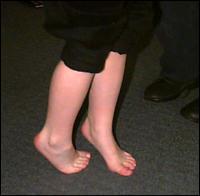My Child is Toe Walking, Should I Be Concerned?

John D. Goodner D.P.M. is a board-certified foot and ankle surgeon. He specializes in treating foot, ankle, and leg injuries in children, teenagers, and adults. He is trained to perform the latest minimally invasive and arthroscopic surgical techniques. Growing up locally in Broward County, he was a two-sport varsity letterman... more
- In an UNCOMPENSATED PATIENT WITH TIGHT CALF MUSCLES the child or adult walks almost exclusively on their toes without the heel touching the ground. The foot does not compensate or implode, as the arch stays very upright. The arch stays structurally sound because the ligaments that hold the bones together in the foot are exceptionally tight. Compensation has to occur elsewhere. This usually is present in the knee or back. The knee may hyperextend to force the center of a person’s weight more backwards because in a toe-walker it is shifted forward. If the spine compensates it will hyperextend to also shift the body weight more correctly so that we do not fall forward in walking.
- In a PARTIALLY COMPENSATED PATIENT WITH TIGHT CALF MUSCLES the foot ligaments are typically not as strong and the arch is not as tight. In this case the arch will slightly implode or lower. When the patient walks there will be a slight bounce in their gait. During walking there is a premature heel lift and the patient typically looks like they are “bopping”. Over time, these patients start destroying their arch. Some compensation may also occur in the knee or spine but to a lesser extent than in the uncompensated toe-walker.
- In a FULLY COMPENSATED PATIENT WITH TIGHT CALF MUSCLES the arch will dramatically lower or even completely collapse. These are by far the worst kinds of feet, despite the fact that it looks the best during gait as the patient’s heel touches the ground. In these children or adults the ligaments holding the arch together are very loose. During walking the tightness to the calf muscle does not allow the ankle to move as it should. Instead, all the stress goes to the arch and the arch collapses. What is seen is a flat arch and a poor ability to push off during gait. There is no bounce in their gait and they do not walk on the balls of their feet most typically. The child or adult will have a slower cadence in walking. The knee and the back are affected dramatically because the base of support is not present in such a flat foot. People with this condition often prefer more sedentary activities because of the typical fatigue that occurs prematurely during walking or activities. The ability to push off is poor and it is similar to trying to push off on sand. The foot is unable to load, lock and push off like a rigid structure should. This is because the foot is in a collapsed state and the foot functions like a loose bag of bones.
CAUSES:
• Normal developmental finding.
• Excessive tightness of the calf muscles.
• Neurological causes, causing muscle spasticity.
• Abnormal ankle bone structure (bone block).
SIGNS AND SYMPTOMS:
• Inability to walk in a normal heel-toe gait.
• Persistently on the ball of the foot when walking.
• Bouncing type gait or gait that appears abnormal.
• Pain in legs, especially at night.
TREATMENT:
- Thorough history and physical exam. Rule out neurologic causes.
- For mild cases, home stretching may help to reduce the calf muscle tightness.
- Night splints to keep the muscle passively stretched while sleeping.
- For moderate cases, casting the lower leg and foot to stretch the calf muscles for 2-8 weeks to improve muscle flexibility.
• Night splinting following cast immobilization to maintain flexibility of the muscle.
• For severe cases that are unresponsive to casting, surgery to surgically lengthen the muscle covering (gastroc aponeurosis) or the entire tendon (Achilles tendon lengthening).
PROGNOSIS:
• Excellent long-term results with the casting method and night splint follow up.
• If the child has an associated flatfoot or a foot that points to the outside, more immediate treatment is necessary to prevent long-term problems including a permanent arch collapse.








